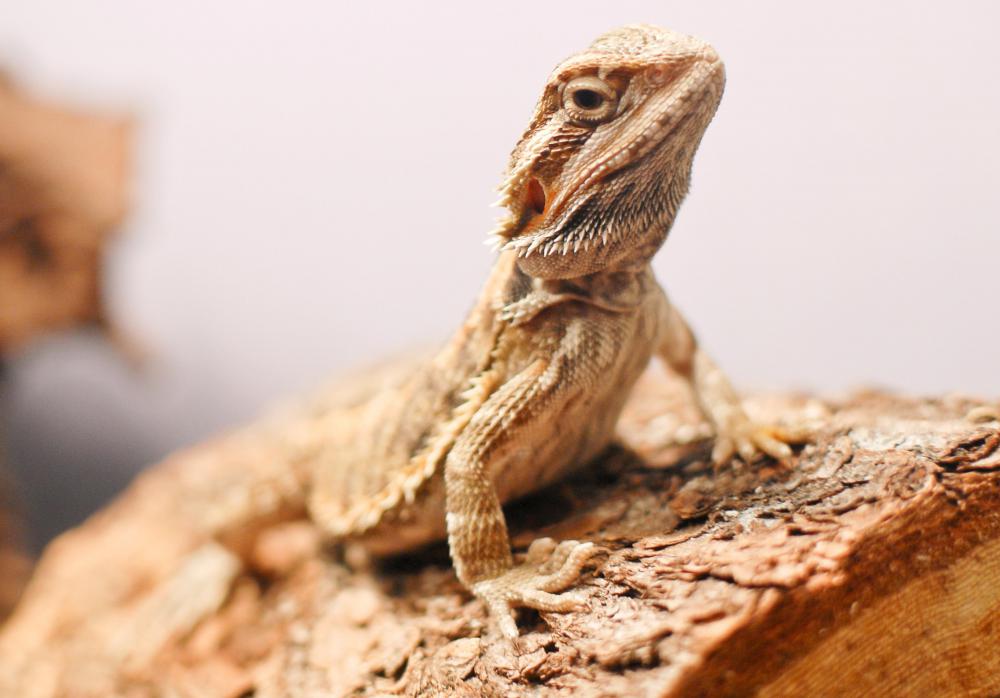At AllThingsNature, we're committed to delivering accurate, trustworthy information. Our expert-authored content is rigorously fact-checked and sourced from credible authorities. Discover how we uphold the highest standards in providing you with reliable knowledge.
What Is a Bearded Dragon?
A bearded dragon is a medium-sized lizard native to Australia. It has become an enormously popular pet in the Americas and Europe due to their gentle nature and manageable size. All members of the genus Pogona are bearded dragons, but the species most often found as pets is Pogona vitticeps. There are eight species of bearded dragon in total.
Bearded dragons are one of the easier lizards to look after as a pet. Their docility ensures the owner rarely needs to worry about them biting or attacking visitors, though they may occasionally hiss at newcomers. They can subsist primarily on readily available vegetable matter, supplemented with small amounts of insects.

While some pet lizards — such as iguanas — require large enclosures and constant attention, bearded dragons are comfortable in much smaller areas. A tank for a bearded dragon should have a colder and hotter side. The hot region should be around 95° F (35° C) for adults and 110° F (43° C) for younger bearded dragons. Bearded dragons should never be subjected to temperatures lower than 65° F (18° C), and the cold side should be kept substantially higher, around 85° F (29° C).

The Pogona vitticeps, also known as the central bearded dragon or inland bearded dragon, is the most common species kept as a pet. This reptile is found in the interior of Australia, in every territory save Western Australia. For the genus, this species is on the larger side, with adults reaching lengths of up to 24 inches (61 cm).
Also known as Mitchell's bearded dragon, Pogona mitchelli is found in the interior of the Northern Territory and the north end of Western Australia, including a large range in the Great Sandy Desert. P. mitchelli is among the smallest of the bearded dragons, averaging only 5.5 inches (14 cm). The most prominent feature of P. mitchelli are its large conical head spikes, which are not seen on any other species.

Pogona minor, also known as the Dwarf bearded dragon, is found throughout the Great Sandy Desert. There is some speculation that P. michelli is simply a sub-species of the Dwarf dragon. This species has very short legs and a short tail, making it easily distinguished from its counterparts.
The Pogona barbata species is found along the entire east coast of Australia. Unlike other Pogona, this species will often feed on other, smaller lizards.
The small-scaled bearded dragon, Pogona microlepidota, is found only in a tiny region of northern Western Australia. Its scales and spikes are noticeably smaller than those found on other Pogona. Its primary habitat is woodland.
Lawson's bearded dragon has the scientific name Pogona henrylawsoni. The full range of P. henrylawsoni is not known, but it has been identified as inhabiting most of Queensland and parts of the Northern Territory. The beard which gives these lizards their name is most pronounced in P. henrylawsoni, and they are the second most common pet dragons.
Pogona minima, the Western bearded dragon, is found on the south-west coast and interior of Western Australia. It lives mostly in woodland environments, though its range includes coastal dunes and desert as well.
The Nullabor bearded dragon, Pogona nullabor, is another rather rare species, found only in a small strip of southern Western and South Australia. It is easily distinguished by large white stripes along its back and pronounced spines on its side. P. nullabor is almost never found as a pet, due to its resistance to breeding in captivity and relative rarity in the wild.
Frequently Asked Questions
What exactly is a bearded dragon?
A bearded dragon is a type of lizard native to the arid, rocky environments of Australia. Known scientifically as Pogona, these reptiles are named for the distinctive 'beard' of spiky scales located around their throat, which can puff up and darken when they are threatened or trying to show dominance.
How long do bearded dragons typically live?
Bearded dragons have a lifespan that ranges from 10 to 15 years in captivity, provided they receive proper care, including a balanced diet, appropriate lighting and heating, and regular veterinary check-ups. Their longevity is influenced by their environment and genetic factors.
What do bearded dragons eat?
Bearded dragons are omnivores, meaning they eat a mix of plant and animal matter. Their diet includes a variety of insects like crickets and mealworms, along with greens, fruits, and vegetables. It's important to provide a balanced diet to ensure they receive all the necessary nutrients for good health.
Can bearded dragons be kept as pets?
Yes, bearded dragons are popular pets, especially for those new to reptile keeping. They are known for their docile temperament and ability to bond with their owners. However, they require a well-maintained habitat and specific care to thrive, including a temperature-controlled environment and UVB lighting.
How big do bearded dragons get?
Bearded dragons typically grow to about 18 to 24 inches in length, including their tail, with males generally being larger than females. Their size is influenced by their species, diet, and habitat. Providing a spacious enclosure and proper nutrition from a young age is crucial for healthy growth.
What kind of habitat do bearded dragons need?
Bearded dragons need a habitat that mimics their natural environment, which should include a basking area with temperatures around 95-110°F, a cooler area around 80-90°F, and a UVB light source to facilitate calcium absorption and prevent metabolic bone disease. The enclosure should be spacious, with areas for hiding and climbing.
AS FEATURED ON:
AS FEATURED ON:













Discuss this Article
Post your comments